Despite past distorted messages about cannabis being a gateway drug or leading to the use and abuse of more addictive and harmful substances, many people today believe that cannabis can be used as a harm reduction tool. I understand that it is sexual.
Whether individuals are looking to reduce or eliminate opioid use for medical reasons or people who use drugs to reduce withdrawal symptoms and cravings, research shows that cannabis may help. It's becoming increasingly clear.
In one recent study on this topic, researchers at the University of British Columbia (UBC) took a closer look at cannabis use and the management of stimulant cravings.Eventually their research results were published in a journal addictive behaviorshowed that cannabis is not only widely used to manage stimulant cravings, but may also be an effective strategy to reduce stimulant use.
Cannabis as harm reduction for other drug use
Researchers believe that medical and recreational cannabis reform will also address other debates, namely how cannabis use interacts with other high-risk substances and whether cannabis alternatives are commonly utilized as harm reduction tools. We are paying attention to how this opens the door to a discussion of
Given the ongoing drug toxicity crisis and the prevalence of fentanyl contamination in many substances, researchers believe that investigating cannabis as an alternative to stimulant use will help “drug users at increased risk of overdose.” “There is potential for important public health and harm reduction measures to be gained between the two countries.” and other drug-related harms. ”
To further analyze how cannabis use affects stimulant users, researchers studied three cohorts in Vancouver, Canada: the Youth At Risk Study (ARYS), the Vancouver Injecting Drug Users Study; Data were collected from the AIDS Care Cohort to Evaluate Research (VIDUS). Exposure to Survival Services (ACCESS).
Researchers used a cross-sectional questionnaire alongside a logistic regression model to analyze the relationship between cannabis use to manage stimulant craving and self-reported changes in the frequency of stimulant use. A total of 297 participants reported cannabis and stimulant use in the past 6 months and were included in the study.
Cannabis is a common strategy for reducing stimulant use
Among participants, 45.1% reported using cannabis to manage stimulant cravings, and 77.6% of participants reported using cannabis to use stimulants such as powder cocaine, crack cocaine, and methamphetamines. actually decreased.
Researchers found that the use of cannabis to manage cravings was significantly associated with decreased stimulant use, especially among people who used crystal meth daily, but among crack cocaine users, the use of cannabis was significantly associated with decreased meth use. It was pointed out that there was no significant association with the decrease.
Although the study doesn't provide all the answers, lead author Dr. Hudson Reddon noted the importance of the results.
“While our findings are not conclusive, we believe that cannabis may be a useful tool for some people, particularly those who use stimulants, who want to better manage their unregulated stimulant use. This supports a growing body of scientific evidence that this may be the case,” Dr. Reddon said. Said. “This suggests new directions for harm reduction strategies for drug users.”
Promoting related research and further investigation
Although it is certainly an adjacent but vastly different issue, countless studies have investigated the subject of cannabis as a means to limit or replace opioids in medical use.
Recent research shows that cannabis may be comparable to opioids in treating pain, yet provide more comprehensive relief, and patients significantly reduce their use of opioids after starting a medical cannabis prescription or replace it completely. Another recent study also found that CBD suppressed opioid craving in rats.
There is far less research available on the relationship between cannabis and recreational drug use and abuse, but the UBC findings echo previous research.
2021 Survey Similarly, we found that cannabis is commonly used as a harm reduction strategy to replace stimulants and opioids.another 2023 survey We found that cannabis is often used as a harm reduction strategy for people who have difficulty accessing addiction treatment or who use substances for which effective treatment options are limited.
Dr. Zach Walsh, a clinical psychologist and professor at the University of British Columbia Okanagan, called the UBC study's results “promising” and emphasized the need for further research on the topic.
“[The findings] “This highlights the need for more comprehensive research to understand the full potential of cannabis in the context of the overdose crisis,” said Dr. Walsh.




